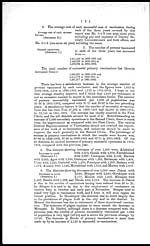Medicine - Vaccination > 1902-1928 - Report on vaccination in the United Provinces > Vaccination United Provinces of Agra and Oudh 1902-1913 > 1899-1902 - Triennial report on vaccination in the United Provinces of Agra and Oudh for the years 1899-1900, 1900-1901 and 1901-1902
(16) Page 3
Download files
Individual page:
Thumbnail gallery: Grid view | List view

( 3 )
Districts showing highest and
lowest number of persons suc-
cessfully vaccinated per 1,000 of
population, with number of deaths
from small-pox. (Statement I.)
10. The number of persons successfully vaccinated per 1,000 of
population in 1901-1902 was highest (96.14)
in Garhwál, which, as a result of the protec-
tion afforded, shows the lowest average
annual ratio of deaths (.01) from small-pox
during the previous five years. Garhwál was
followed by Almora with 56.71, Hardoi with 46.84, Hamírpur with 41.31,
Naini Tál with 39.40, Pilibhít with 38.30, Sítapur with 37.41, Jalaun
with 35.94. The number of deaths from small-pox in these districts was
4, 1, 14, 1, 2, 1, 2, and 82 respectively. In Hardoi (.01) and Jalaun (.20)
alone of the above districts were the deaths from small-pox sufficient to
give an annual death-rate per thousand of population. In the other dis-
tricts the number was too low to give any appreciable rate per 1,000
of population. The districts showing the lowest number of persons
successfully vaccinated per 1,000 of population were Allahabad with
22.10, Farrukhabad with 23.35, Bara Banki with 25.19, Gonda with
26.14, Ballia with 26.21, Basti with 26.72, Azamgarh with 27.52, and
Benares with 27.59. The number of deaths and death-rate from small-pox
in these districts were respectively 57 and .04, nil and nil, 10 and nil, 36
and .02, 42 and .04, 4 and nil, 11 and nil, and 13 and .01.
Five years' averages.
(Statement I.)
11. Taking the previous five-year figures, the best protected district
was Garhwál with an average of 71.77
persons successfully vaccinated per 1,000 of
population. The previous five-year average death-rate from small-pox in
this district was .01, the lowest in the Provinces. Garhwál was followed
by Almora with 58.10 (persons successfully vaccinated per 1,000 of popu-
lation), and .09 (death-rate from small-pox), Sitapur with 44.70 and .57,
Hardoi with 41.26 and 1.02, Dehra Dún with 38.33 and .07, Etah with
38.03 and .88, Bulandshahr with 37.11 and .10, Naini Tál with 35.60 and
.07. The average death-rates of Hardoi and Etah were above the pro-
vincial average of .58.
Garhwál, and indeed all the hill districts are splendidly protected,
the people being most anxious to be vaccinated three or four times.
Worst protected districts.
(Statement I.)
12. The worst protected districts in the 5-year period were Allah-
abad with 18.58 persons successfully vacci-
nated per 1,000 of population, and 1.06
average annual death-rate from small-pox, followed by Bara Banki with
20.39 and .36 average annual death-rate from small-pox, Azamgarh with
20.54 and .50 average annual death-rate from small-pox, Farrukhabad
with 20.95 and .30 average annual death-rate from small-pox, Jaunpur
with 23.41 and 1.30 average annual death-rate from small-pox, Sultánpur
with 23.73 and 1.45 average annual death-rate from small-pox, Bánda
with 23.94 and .47 average annual death-rate from small-pox, and Gorakh-
pur with 24.32 and .32 average annual death-rate from small-pox. In
taking a series of well protected and a series of badly protected districts,
the incidence of small-pox and a higher death-rate from the same is always,
as might be expected, most marked in the latter. In a period of five
years I find there were 2,551 deaths from small-pox in the eight best
protected districts, while there were 7,667 in the eight worst protected
districts in the same period.
Vaccination in proportion to
births in 1901-02.
13. The percentage of successful primary vaccinations in proportion
to births was 44.11 for infants under one
year, and 24.51 for children over one and
under six years of age, compared with 37.62
and 19.30 in 1899-1900 and 43.76 and 26.80 in 1900-1901. The per-
centages for infants (under one year) for the First Circle during the three
years were 48.00, 54.96 and 53.97 compared with percentages for the
Second Circle of 27.64, 33.10 and 34.13 respectively, which shows that
there is much room for improvement in the Second Circle. The First
Set display mode to: Large image | Zoom image | Transcription
Images and transcriptions on this page, including medium image downloads, may be used under the Creative Commons Attribution 4.0 International Licence unless otherwise stated. ![]()
| Permanent URL | https://digital.nls.uk/87230877 |
|---|
| Attribution and copyright: |
|
|---|




